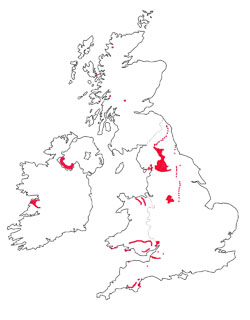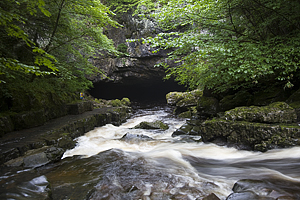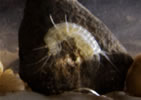As you enter a cave it is immediately obvious that green plants are no longer growing and, apart from a few spiders, there seems to be little else in there.
After a while you may notice a moth on the wall, or a fly, a different spiders web, some fungi growing on a log. And in the water a fish, and deeper in the cave as you crawl along with your nose nearer the floor you may spot a shrimp, a flatworm and other small crawling things that all seem to be white.
When you come out of the cave you may notice you can smell the outside before you can see it, and then how the plants change from simple plants like mosses to ferns then flowering plants as you leave the cave.
This website is to help cavers identify the organisms they see whilst visiting the caves of Britain, and to help them understand the relationships between these organisms. It includes life around cave entrances, temporary visitors to caves as well as the inhabitants of the dark zone. The scientific terminology has been kept to a minimum (!) to help the non specialist - there is a glossary to help with the unfamiliar words. Each region has pages written specifically for that area along with photographs taken from caves in that region.
 |
Caving regions of Great Britain and Ireland
Click on any image for a larger version. |
On this website the regions are: Devon, Mendip, Wales (includes the Forest of Dean), Peak District and Yorkshire (includes parts of neighbouring counties such as Lancashire, Cumbria and County Durham). The caves are predominantly in limestone.
Hopefully the website will inspire you to take a second look at the creatures you see underground - many caves do not have a comprehensive list of organisms and there are many new discoveries to be made.
BIOSPELEOLOGY is the study of the organisms that live in caves and other subterranean regions. All these cave dwelling organisms have an official Latin name, and sometimes a common English name as well. The Latin name is in two parts - the first is the generic or genus name and starts with a capital letter, the second is the specific or species name. Many organisms found underground do not have a common English name, but all will have a Latin name - unless you find an undiscovered species! The Latin name of a species may be changed as new information comes to light regarding its relationship with other related species.
NAVIGATION Click on the main headings on the navigation bar (on the left) to open the subheadings - these open below the main headings. The caves mentioned on this site are just examples of where the organism can be found, it is not intended to be a complete list. References have been left out of the text and have been collated under Acknowledgements.
PHOTOGRAPHS and COPYRIGHT Click on the photographs for a larger image. The aim of the website is to educate cavers and so the information and photographs contained may be used by e.g. cave instructors for presentations. Contact A. Lewington for other uses of the photographs including commercial use. Higher quality images are available.
CONTACT This site can only present a snapshot of what lies beneath but should you discover any omissions, mistakes or broken links please contact: Andy Lewington :
 |
The River Mellte flows into the large entrance of Porth yr Ogof, South Wales
Click on any image for a larger version. |
|

